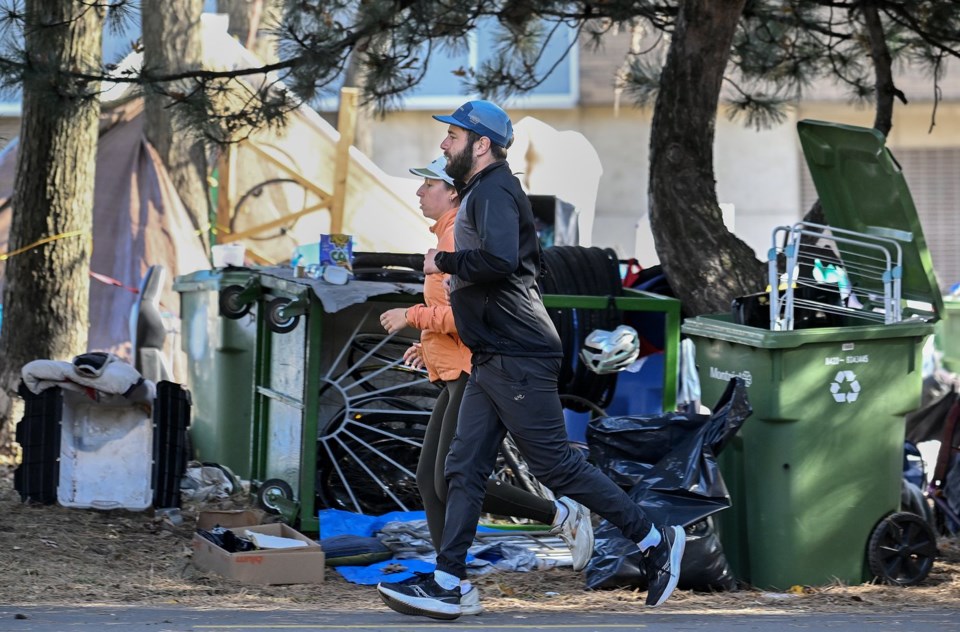MONTREAL — On a strip of grass dividing a busy east-end Montreal thoroughfare from a block of residences in the Hochelaga-Maisonneuve district stand about two dozen tents, a reflection of a housing market that can't provide enough affordable homes.
Tents along that strip of land adjacent to Notre-Dame Street have come and gone since 2020, when the number of homeless people rose rapidly during the COVID-19 pandemic. Homeless people build shelters there and in other empty spaces across the city, and social workers — under police supervision — dismantle them, forcing campers to pitch their tents somewhere else, only to evict them once again.
Montreal and other Canadian cities are struggling with the seemingly intractable problem of homelessness and trying various approaches to stop people from sleeping rough, often with mixed results. But while the issue of homelessness may not be easy to fix, experts say what's clear is that evictions aren't helping.
Isidro Escobar, 22, has called one of the tents on Notre-Dame Street home for almost a year. Before that, he lived in a tent by the old C–°¿∂ ”∆µ tower 1.5 kilometres down the street.
“I lost everything after my divorce,” he said Thursday.
Escobar said the City of Montreal has given him two eviction orders. But he said that if he's forced to leave, he'll pitch a tent somewhere else.
Not far from Escobar, Devint Vézina, 40, was rebuilding his tent for the fifth time, he said, adding his latest one will be big enough for 10 people.
“Where do you want me to go? That’s the real question.”
When asked, a Montreal city spokesperson didn't specify where people like Escobar and Vézina should go, but said that "urban encampments are not a viable, safe or permanent solution.” The city said it is working with community organizations to get people sleeping rough into affordable housing with services adapted to their needs.
Montreal does not keep a list of encampments or send workers to look for them. Instead, when a tent encampment is reported, officials evaluate whether it poses a safety risk, including for fires. In August Montreal announced a pilot project for 60 modular housing units for the unhoused by March 2025.
The City, however, continues to dismantle homeless encampments — 110 of them between January and May 2024, according to a report by Le Journal de Montréal.
Montreal is not addressing the homelessness problem by evicting people from encampments, said James Hughes, president and CEO of Old Brewery Mission. Municipalities, he said, need to follow the lead of cities like Houston, Texas, which creates plans for vulnerable people to get into housing while providing support for them while they are staying in an encampment.
"Old and coercive policies" like evictions, Hughes said, are akin to playing “Whac-A Mole" — forcing people out of one area only to have them pitch a tent down the street, or into a spot far from public view where they can't receive aid if they are in trouble.
The City of Halifax, meanwhile, has taken a different approach to Montreal. There are five designated locations across Halifax on which homeless people can pitch a tent, a “temporary response until suitable shelter and housing options are available," the city said.
The people sleeping rough at these locations have access to toilet facilities, potable water and needle collections. As well Nova Scotia has purchased small, self-contained Pallet shelters for unhoused people in the province, with 85 destined for the Halifax region.
Jeff Karabanow, a professor at Dalhousie University's school of social work, described designated homeless encampments as deeply problematic, unhealthy and undignified. Still, he said, they are worth having until resources are rerouted from emergency shelters to affordable housing.
However, municipalities that adopt policies tolerating encampments may suffer political backlash at the ballot box. Earlier this month Andy Fillmore, a former Liberal MP, was elected Halifax mayor in a landslide after taking aim at encampments, saying the city’s approach has had the effect of attracting out-of-province unhoused people — a claim that Karabanow said is untrue.
For its part, the City of Toronto said it has adopted a "people-first, human rights-based approach" to connect people with shelters, services and housing. Advocates say the city began changing how it responds to homeless people after a Toronto ombudsperson investigation found "significant unfairness" in the way officials cleared encampments in 2021.
Toronto community worker Diana Chan McNally believes the city's change in attitude is a step in the right direction but remains flawed because only some encampments receive support.
"We have a two-tier approach," she said, adding the city continues to dismantle encampments and there still isn't enough affordable housing to meet demand.
Part of the problem is that coexistence is uneasy for people in encampments and residents of nearby homes.
"No neighbourhood in the city wants the new homeless resource, or wants the subsidized housing in their area, or wants the tiny homes in their area, whatever the solution you're looking at people object," said David Chapman, executive director of community group Resilience Montreal.
Hugo Michel-Verville, who lives across from the Notre-Dame Street encampment, said he has been spat on and yelled at by his unhoused neighbours. Calls to the City of Montreal, to police and to intervention workers have been ignored, he said.
“It doesn’t seem like there’s a road map either, short-term or long-term, to solve this, and this is what’s frightening."
This report by The Canadian Press was first published Oct. 27, 2024.
Joe Bongiorno, The Canadian Press



